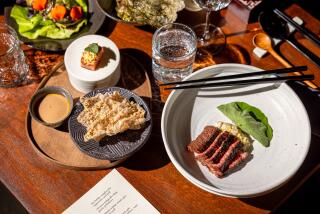Pig ears? Theyâre seriously tasty
I promise you this isnât a story about dog treats.
If youâve been dining out at some of L.A.âs hippest chef-driven restaurants lately, you might have noticed a recurring ingredient on the menu. Pig ears. You heard me, pig ears.
Recently, at the L.A. Times Taste event, I decided to serve a pig ear terrine dish from my restaurant Lukshon. Cold, thinly sliced pig ears marinated in black vinegar, Sichuan spices and white sesame oil with thin slices of pickled carrots and scallions. The dish got one of two reactions. âOoh, I love pig ears!â or âIs that really pig ears?â Excitement or disbelief. The faces told the story. People either came for seconds or walked away looking totally grossed out. One person said to me, âWho on earth would eat pig ears?â
Thatâs what I expected, as pig ears arenât popular in mainstream American culture yet. But thatâs changing. Itâs all part of the worldwide culinary movement of nose-to-tail cookery championed by many renowned chefs such as Fergus Henderson of the London restaurant St. John, who literally wrote the book on the subject. Or closer to home, chefs like my friend Chris Cosentino, who is well known for his creativity with every conceivable part of a pig. As I see it, itâs an exciting way to experience something new and turn dinner into an adventure.
The consumption of pig ears is nothing new, though. It might seem like the latest trendy provocative ingredient meant to arouse our culinary curiosity, but itâs actually difficult to find a culture that doesnât eat them.
Nearly every cuisine in Europe and Asia has a preparation. They are most often fried crispy. But theyâre also served boiled, braised and roasted.
Frying them crispy is an obvious choice, as the outer layers of skin become crunchy and the inner layer of cartilage becomes gelatinous and chewy. The flavor of the ears could be described as sweet, rich porkiness. If youâve never tried them, you should; theyâre seriously good. Down, boy!
Iâve seen fried pig ears paired with Brussels sprouts as a crunchy garnish or sprinkled over a salad of bitter greens with a tart lemon dressing. I have served them fried on my menus as well. Last year at Fatherâs Office, I served them cut into small triangles resembling tortilla chips, fried crisp and accompanied by a spicy tomatillo salsa. We called the dish pig ear chips and salsa.
But lately Iâve been really intrigued by Chinese charcuterie. One treatment of pig ear that has really stood out for me is a classic Sichuan preparation. They are boiled with aromatic spices until tender, then stacked up and pressed down just like a classic French terrine.
Once set, the terrine is thinly sliced, marinated in vinegar and spices and served cold. The cross section of the ears sort of looks like a cross between a relief map and strips of bacon. Itâs the high gelatin content of the ears â easy to miss when fried â that makes the dish work.
Try slicing the terrine to different thicknesses. Cut paper thin on a meat slicer the ears become soft and supple, almost like mortadella. Slice it by hand slightly thicker and youâll get a better sense of the crunchy cartilage and firm gelatin.
Pig ears prepared in this manner can be served a number of ways. Try adding a few slices to a charcuterie platter with a little hot Chinese or English mustard. I also love using pig ears prepared this way in a banh mi sandwich: Thin slices of the pressed ears with maybe a little pork patĂŠ on a nice crunchy baguette topped with pickled carrots and jalapeĂąos. Perfection.
Look at it this way â if your friends wonât try it, at least youâll have the happiest dog on the block.
More to Read
Eat your way across L.A.
Get our weekly Tasting Notes newsletter for reviews, news and more.
You may occasionally receive promotional content from the Los Angeles Times.










